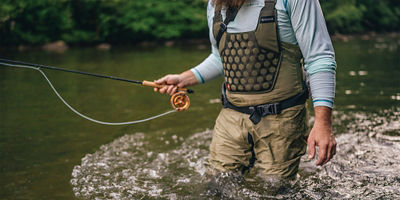
More often than not, fishing puts you right in the middle of the weather. Wading across a stream, working the end of a pier, or floating in the middle of the lake, you’re exposed to all the elements. That’s part of the draw. But if you’re not prepared with the right clothing, head to toe, some of that love can be quickly lost. Shorts work well until you’re sunburned; jeans are OK until it rains. Suddenly, the wrong apparel choice goes from uncomfortable to unsafe. Maximize your time on the water by making sure you’re outfitted for whatever Mother Nature throws your way.
In the Heat: Think Sun Protection
Regardless of the type of fishing, if the sun is shining—especially during longer summer days in warm climates—your clothing needs to protect you from the sun. Even on warm days, a long-sleeve (and often hooded) shirt makes a big difference. Look for technical fabrics with an Ultraviolet Protection Factor (UPF) rating of at least 30. Many should also have cooling and sweat-wicking properties. Something loose-fitting will keep you comfortable, and synthetic fabrics like polyester will effectively move moisture from your body and dry off quickly if splashed.
The same goes for your pants: Long, light, and loose-fitting will do a better job of protecting you in the heat. In warmer waters (where you don't need waders), sandals or water shoes are a nice way to keep cool—though don’t forget about sunscreen on the tops of your feet and toes, especially in shallow and clear water.
Find a good hat to protect your face from the sun (the more brim, the more protection for your face and neck), and consider some lightweight gloves. You can find fingerless gloves made of the same wicking, sun-protective materials as your shirts, which will keep the often-forgotten backs of your hands from burning. And rather than dealing with sunscreen or full-brimmed hats, many anglers opt for larger neck gaiters, often made of wicking synthetic materials, to protect the neck (and face, too) from sun and wind burn, as well as biting bugs.
In the Cold: Layer Up
In colder waters, you’ll likely be wearing waders to keep you dry. Many popular waterproof/breathable options don’t do much to insulate you, however, so you need to add layers underneath. Wear materials like wool or polyester, which will stay warm even if they get a little wet. Avoid cotton items when fishing on colder days—any water on the fabric will sap the warmth from your body.
You can actually wear a lot of the same sun-protective layers on cold days as you might on warmer ones (you still need UV protection). From that base, add on more layers (rather than a single jacket), which allows you to customize the amount of warmth needed for changing temperatures and activity. Insulating layers like polyester flannel, wool sweaters, fleece, or down jackets all do the trick with varying degrees of warmth. Again, steer clear of items like cotton sweatshirts. Pick a pair of gloves and a hat that match the conditions





















